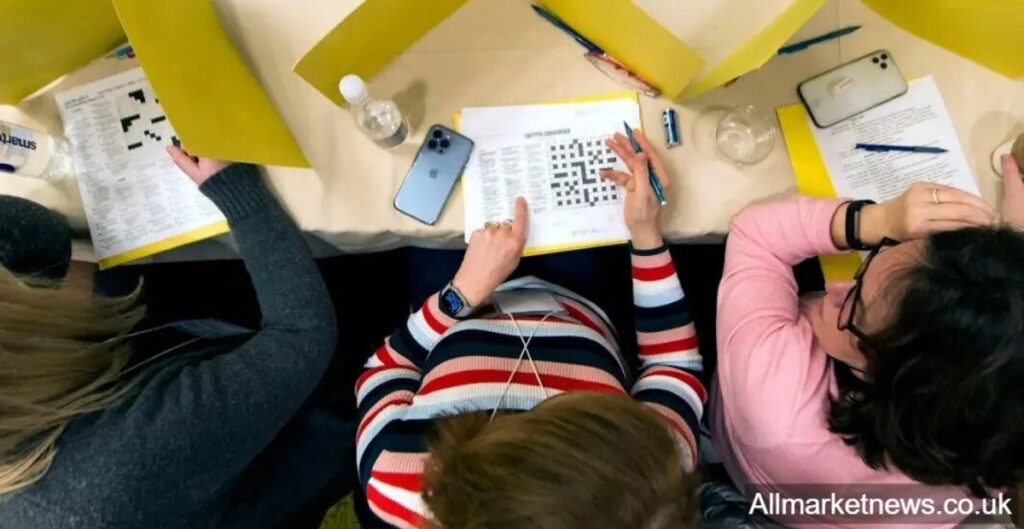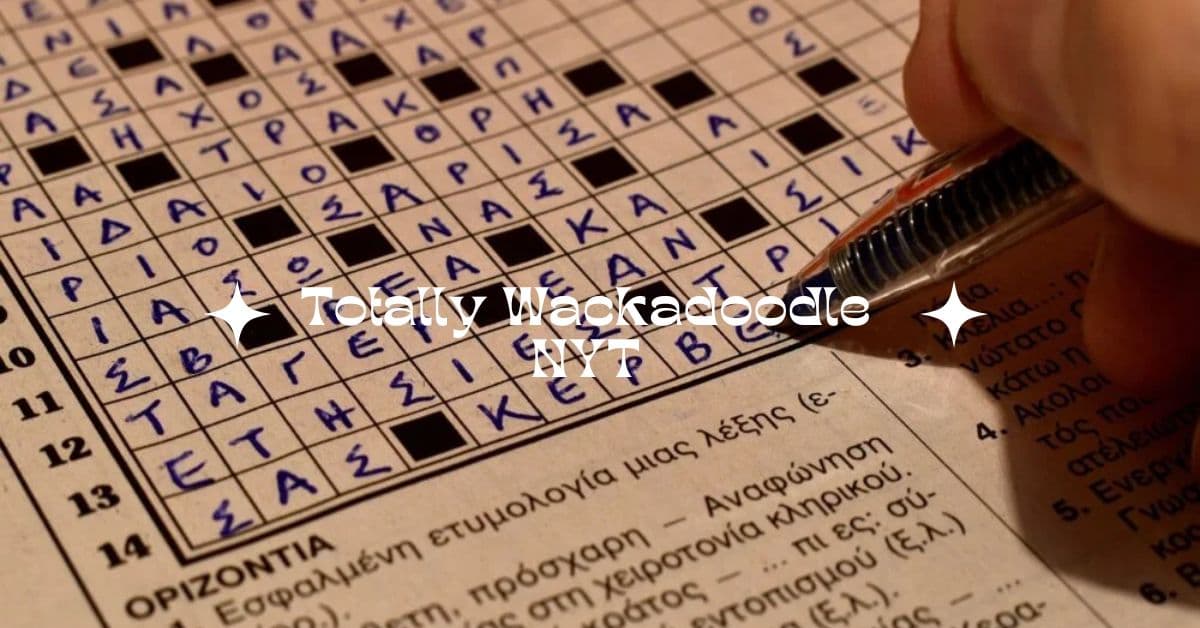Totally Wackadoodle NYT: A Deep Dive into the Quirky World of New York Times Crossword Clues
The New York Times crossword puzzle: a daily ritual for wordplay enthusiasts, a bastion of intellectual challenge, and occasionally, a source of delightful bewilderment. Enter the realm of “totally wackadoodle NYT” clues, a whimsical term coined by crossword aficionados to describe entries that defy convention and push the boundaries of puzzle solving.
This article delves into the curious world of “totally wackadoodle NYT” clues, exploring their history, impact, and the fervent community they’ve ignited.
A Wackadoodle History: Defying Expectations Since When?
Pinpointing the exact origin of “totally wackadoodle NYT” is tricky. The term itself likely emerged organically within the online crossword community in the past decade, reflecting the growing presence of these unconventional clues.
However, the spirit of wackadoodle has been a hallmark of NYT crosswords for decades. Will Shortz, the longtime crossword editor, has championed the inclusion of witty and challenging clues, fostering a culture of innovation and surprise.
Early examples include clues that rely on historical context or obscure references. A 1978 clue for “dodo” might read: “Extinct bird seen by the Dutch.” While straightforward, it requires solvers to possess a specific historical tidbit.
Fast forward to the 21st century, and clues became more layered and playful. Imagine encountering a clue like “They might leave you hanging” for the answer “cliffhangers.”
Here, the wordplay hinges on the double meaning of “hanging” – both dangling and left unresolved in a story.
The Wackadoodle Effect: How These Clues Challenge and Delight
“Totally wackadoodle NYT” clues inject a potent dose of chaos into the structured world of crosswords.

They demand a shift in thinking, encouraging solvers to move beyond straightforward definitions and embrace ambiguity. Here’s how they impact the solving experience:
Enhanced Challenge: These clues require a broader knowledge base and a willingness to think outside the box. Cultural references, historical trivia, and obscure wordplay become essential tools for deciphering the answer.
A Spark of Joy: When a “totally wackadoodle NYT” clue finally clicks, it’s a moment of pure satisfaction. The “aha!” moment is amplified by the unexpected nature of the clue, making the solving experience all the more rewarding.
Building Community: The shared struggle and eventual triumph over these perplexing clues forge a bond among crossword enthusiasts. Online forums and social media discussions buzz with attempts to decode these entries, fostering a sense of community and shared passion.
Read: Molly Leigh Burton: All About Daughter Of Don Burton And Dolores O’riordan
The Great Wackadoodle Debate: Pushing Boundaries or Going Too Far?
The inclusion of “totally wackadoodle NYT” clues has sparked lively debates within the crossword community. Here are some key arguments:
Advocates of Wackadoodle: Proponents argue that these clues elevate the solving experience by demanding creativity and critical thinking. They celebrate the element of surprise and the intellectual challenge they bring.
Opponents of Wackadoodle: Critics argue that these clues prioritize cleverness over fairness. Overly obscure references or puns can alienate new solvers and create an uneven playing field. They advocate for a balance between innovation and accessibility.
The debate reflects the ongoing evolution of crossword puzzles. Will Shortz himself acknowledges the importance of maintaining a level of difficulty that caters to a broad audience.
The ideal “totally wackadoodle NYT” clue should be challenging yet ultimately solvable, offering a sense of accomplishment without resorting to unfair obscurity.
The Future of Wackadoodle: Innovation and the Evolving Puzzle Landscape

“Totally wackadoodle NYT” clues represent a significant shift in crossword design. They’ve pushed constructors to embrace new forms of wordplay, explore thematic connections, and experiment with unconventional formats. Here’s how they’re shaping the future of crosswords:
Evolving Clue Types: We can expect to see a rise in even more creative clue types inspired by “totally wackadoodle NYT.” Imagine clues that incorporate multimedia elements, like referencing a specific scene in a movie, or interactive components that require solvers to manipulate the grid itself. These innovations blur the lines between traditional crosswords and interactive puzzles, appealing to a new generation of solvers.
The Rise of Themed Puzzles: “Totally wackadoodle NYT” has opened doors for more adventurous themed puzzles. A puzzle might revolve entirely around pop culture references or wordplay based on historical events. These thematic elements can add an extra layer of challenge and enjoyment for solvers with specific interests.
A Balancing Act: Despite the exciting possibilities, maintaining a balance between innovation and accessibility remains crucial. The best “totally wackadoodle NYT” clues will continue to strike a chord – challenging enough to be rewarding, yet fair and ultimately solvable for a broad range of enthusiasts.
Read: Cara Webb Hanson: A Story Of Resilience And Achievement
Wackadoodle Whisperers: Inside the Minds of the Clue Creators
The masterminds behind these quirky clues are the crossword constructors. Let’s peek into their creative process:
Balancing Act Masters: A good constructor understands the delicate balance between challenge and fairness. They strive to craft clues that are clever without being obscure, and surprising without being frustrating.
Masters of Wordplay: Wordplay is the lifeblood of a “totally wackadoodle NYT” clue. Constructors are wordsmiths, adept at weaving puns, double entendres, and other linguistic gymnastics to create mind-bending challenges.
Pop Culture Mavens: Staying current with pop culture references is essential. A well-timed clue referencing a viral meme or a popular TV show can be a delightful surprise for solvers.
Community Listeners: The best constructors keep their ear to the ground, listening to feedback from the solving community. Understanding what resonates with solvers helps them craft clues that are both challenging and enjoyable.
The role of the constructor is not just to create a puzzle, but to curate a solving experience. “Totally wackadoodle NYT” clues are a testament to their creativity and their ability to push the boundaries of what a crossword puzzle can be.
Beyond the Grid: The Social Media Craze and Wackadoodle Discourse

The rise of social media has been instrumental in amplifying the “totally wackadoodle NYT” phenomenon. Here’s how online platforms have shaped the discussion:
A Virtual Community: Twitter, Reddit, and crossword forums have become virtual meeting grounds for crossword enthusiasts. Solvers share their experiences with “totally wackadoodle NYT” clues, seeking help, offering advice, and celebrating triumphs.
The Power of Sharing: Social media allows for real-time discussions about specific clues. Screenshots of particularly perplexing entries circulate, with users dissecting the wordplay, cultural references, and possible solutions.
Humor and Camaraderie: The shared struggle of tackling these challenging clues fosters a sense of camaraderie and humor. Witty tweets and memes capture the frustration and eventual satisfaction of solving a wackadoodle clue.
Social media has transformed crossword solving from a solitary activity into a shared experience. The “totally wackadoodle NYT” phenomenon has become a cultural touchstone, uniting crossword enthusiasts across the globe.
Read: Billy Carson Net Worth: Wife, Age, Biography, And Height
FAQs:
1. Are there any constructors known for their wackadoodle clues?
Many talented constructors contribute to the New York Times crossword, but a few have gained a reputation for their particularly creative and challenging clues. Names like Patrick Berry, Liz Kingsley, and Patrick Blindauer are often mentioned when discussing wackadoodle entries.
2. Do other crossword publications have their wackadoodle clues?
The term “totally wackadoodle NYT” is specific to the New York Times crossword, but the concept of unconventional and challenging clues exists in other publications as well. Look for puzzles with a reputation for wit and wordplay, or explore online communities dedicated to specific crossword publications to discover their brand of wackadoodle goodness.
3. Do “totally wackadoodle NYT” clues ever reference current events?
Absolutely! Constructors often incorporate timely references to keep the puzzles fresh and engaging. This could involve anything from a recent news headline to a trending meme. Staying up-to-date on current events can give you an edge when tackling these clues.
4. I solved a particularly wackadoodle clue! How can I share my triumph with the community?
The joy of solving a challenging clue is best shared with fellow enthusiasts! Social media platforms like Twitter and Reddit are great places to post about your accomplishments. Share the specific clue, and your thought process for solving it, and celebrate the victory with the online crossword community.
Conclusion:
Totally wackadoodle NYT clues are more than just quirky entries in a crossword puzzle. They represent a celebration of wit, a testament to the power of wordplay, and a testament to the ever-evolving world of crossword puzzles. These brain-bending clues challenge us to think critically, embrace ambiguity, and ultimately, appreciate the beauty and complexity of language.
Read more:






